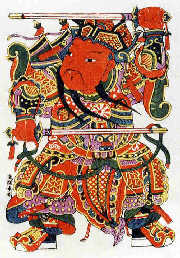 Traditional Wuqiang painting creation includes three procedures-painting, carving andprinting, all handmade. Wuqiang genre features vivid structures, bold brushworks, strong coloring, decorative patterns, and simple scenes but single highlighted themes. Its lines are steady and natural, giving prominence to plainness and antiquity. Its coloring, usually featuring one single color, is simple but full of change. The passionate and harmonious coloring creates a joyful festive atmosphere.
Traditional Wuqiang painting creation includes three procedures-painting, carving andprinting, all handmade. Wuqiang genre features vivid structures, bold brushworks, strong coloring, decorative patterns, and simple scenes but single highlighted themes. Its lines are steady and natural, giving prominence to plainness and antiquity. Its coloring, usually featuring one single color, is simple but full of change. The passionate and harmonious coloring creates a joyful festive atmosphere.
In the first painting stage, the craftsman puts a piece of thin, whitepaperon the original sample painting and copies it by ink brushwork. Then he sticks the copy painting to the prepared wood board, which should be smooth and hard. The most suitable type is an indigenous timber called Dumu. Before he sticks the painting, he usually pastes sesame oil on the board to increase clarity of brushworks and softness of the board.
In the second carving stage, the craftsman carves lines on the wood board, which should be straight and deep to resist wear and tear. Usually, three additional sample print boards should be made in red, yellow and blue respectively.
 In the third printing stage, the craftsman pastes paper on sample boards for print, first black board, then red, pink, yellow, blue and light blue in a row.
In the third printing stage, the craftsman pastes paper on sample boards for print, first black board, then red, pink, yellow, blue and light blue in a row.
Wuqiang New Year painting is a folk art of a farming society. Its subjects, contents and forms all feature strong rural and natural styles. In light with different rural surroundings, diversified New Year styles are created to be pasted in different spots.
For instance, oil light painting is a distinctive style of Wuqiang New Year painting. Made by woodprint and powder paper, the painting is usually pasted on a square-shaped oil light stand. Oil light painting often derives its subjects from Chinese opera stories. Portraits in oil light painting are well structured, exquisitely dressed and boldly colored, representing the peak of Wuqiang New Year painting.
